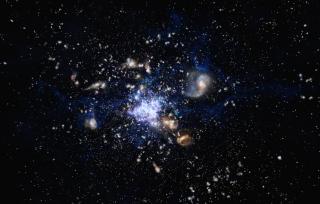Daddi, E.; Valentino, F.; Rich, R. M.; Neill, J. D.; Gronke, M.; O'Sullivan, D.; Elbaz, D.; Bournaud, F.; Finoguenov, A.; Marchal, A.; Delvecchio, I.; Jin, S.; Liu, D.; Strazzullo, V.; Calabro, A.; Coogan, R.; D'Eugenio, C.; Gobat, R.; Kalita, B. S.; Laursen, P.; Martin, D. C.; Puglisi, A.; Schinnerer, E.; Wang, T.
Referencia bibliográfica
Astronomy and Astrophysics
Fecha de publicación:
5
2021
Revista
Número de citas
87
Número de citas referidas
77
Descripción
We have discovered a 300 kpc-wide giant Lyman-α (Lyα) nebula centered on the massive galaxy group RO-1001 at z = 2.91 in the Cosmic Evolution Survey field. Keck Cosmic Web Imager observations reveal three cold gas filaments converging into the center of the potential well of its ∼4 × 1013 M⊙ dark matter halo, hosting 1200 M⊙ yr‒1 of star formation as probed by Atacama Large Millimeter Array and NOrthern Extended Millimeter Array observations. The nebula morphological and kinematics properties and the prevalence of blueshifted components in the Lyα spectra are consistent with a scenario of gas accretion. The upper limits on active galactic nuclei activity and overall energetics favor gravity as the primary Lyα powering source and infall as the main source of gas flows to the system. Although interpretational difficulties remain, with outflows and likely also photoionization with ensuing recombination still playing a role, this finding provides arguably an ideal environment to quantitatively test models of cold gas accretion and galaxy feeding inside an actively star-forming massive halo at high redshift.
Proyectos relacionados

Gas Molecular y Polvo en Galacias através del Tiempo Cósmico
Dos cuestiones fundamentales en la Astrofísica son la conversión de gas molecuar en estrellas y cómo este proceso físico depende del entorno en todas las escalas, desde sistemas planetarios, cúmulos estelares, galaxias hasta cúmulos de galaxias. El objectivo principal de este proyecto es el de estudiar la formación y evolución de galaxias a partir
Helmut
Dannerbauer